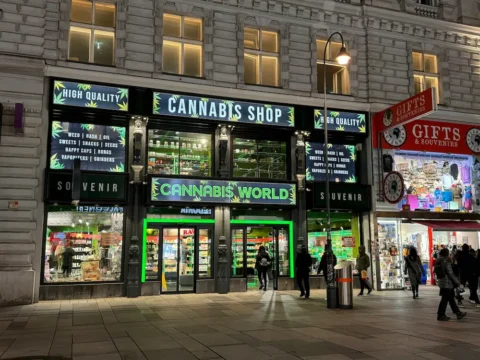What you’ll learn
You’ll discover which states have banned kratom entirely, which have implemented new consumer protection laws, and what these changes mean if you’re currently using kratom. We’ll walk you through federal status, state-by-state updates, and what to do if kratom has become harder to stop than you expected.
If you’re using kratom or considering it, you’ve probably wondered: Is this even legal where I live? More importantly, is it safe?
Kratom’s legal status is changing rapidly across the United States, and for good reason. While the DEA hasn’t moved to ban kratom at the federal level, state lawmakers are increasingly concerned about public safety as reports of liver toxicity, respiratory depression, and physical dependence continue to mount. New laws have taken effect throughout 2025, affecting kratom sales everywhere from gas stations to smoke shops.
But what’s driving these changes? Many kratom products now contain unnaturally high levels of 7-hydroxymitragynine (7-OH), a compound that is found naturally in kratom, but only in very small amounts. At higher concentrations, which are more commonly surfacing, 7-OH acts like a powerful opioid, which can increase the risk of addiction, overdose, and other serious health effects. The FDA continues to warn consumers about these risks, including seizures and substance use disorder.
Here’s what’s happening at a glance: Florida tried to strengthen regulations, but the bill died in committee. Texas just implemented some of the strictest standards in the nation for kratom products. California is moving toward age restrictions. Georgia’s new consumer protection law is now in effect. And North Carolina lawmakers are considering adding kratom to its controlled substance list entirely.
At QuickMD, we help people every day who started using kratom for chronic pain or opioid withdrawal but found themselves struggling with kratom dependence. Many discover that what they thought was a natural alternative has become harder to stop than expected, especially with today’s enhanced kratom products.
Whether you’re currently using kratom, trying to understand these legal changes, or looking for support to transition away from kratom use, we’ll walk you through exactly where things stand as of now and what safer alternatives exist.
Federal kratom ban status
Kratom remains legal at the federal level as of July 2025.
The Drug Enforcement Administration (DEA) has not classified it as a controlled substance, meaning there’s no federal ban in place.
But that doesn’t mean federal agencies support kratom use. The FDA continues to warn consumers about serious health risks, including liver toxicity, seizures, and the potential for addiction.
In fact, the FDA has never approved kratom for any medical use and states that:
Kratom is not lawfully marketed as a dietary supplement and cannot be lawfully added to conventional foods…kratom is not lawfully marketed in the U.S. as a drug product, a dietary supplement, or a food additive…
So, why isn’t there any federal action on kratom yet? The DEA attempted to temporarily reclassify kratom as a Schedule I controlled substance back in 2016, but faced unprecedented public pushback and reversed its stance.
In September 2016, kratom organizations organized the “March for Kratom” at the White House and convinced 51 members of Congress on both sides of the aisle to sign a letter against the DEA’s proposal.
Additionally, kratom supporters sent a petition containing more than 145,000 signatures to President Obama opposing the ban. However, the landscape has shifted since then.
Medical examiner reports now link kratom to 91 deaths, though kratom was the only substance detected in just seven cases, with most involving multiple drugs, including fentanyl and heroin.
Recent research confirms this pattern. A small but important 2024 study from Kern County, California, found kratom present in 4 out of 214 opioid overdose deaths. In every case, kratom was combined with other substances, most commonly fentanyl (3 out of 4 cases).
What concerned researchers was that one death involved kratom combined only with benzodiazepines and psychiatric medications, suggesting kratom’s opioid-like effects can be dangerous even when mixing it with seemingly less risky substances.
The study authors noted they found no kratom-related deaths in 2018 or 2019, then suddenly 4 in 2020, which may reflect kratom’s growing use. More concerning for federal agencies is the rise of enhanced kratom products containing dangerous levels of 7-hydroxymitragynine. It acts like a potent opioid and can cause respiratory depression.
This regulatory gap at the federal level is exactly why individual states have stepped in, creating a complex web of laws that vary dramatically depending on where you live.
State kratom ban laws
With no federal ban in place, individual states have become the primary battleground for kratom regulation. The result is a confusing landscape where kratom might be legal in one state but completely banned in the neighboring one, or even legal statewide but prohibited in specific cities.
States where kratom is banned vs legal in 2025
As of July 2025, six states have completely banned kratom: Alabama, Arkansas, Indiana, Rhode Island, Vermont, and Wisconsin.
In these states, possessing, selling, or using kratom can result in criminal charges similar to other controlled substances. But the bigger story is happening in states that are choosing regulation over prohibition.
Twenty-two states and the District of Columbia now have some form of kratom regulation, driven largely by concerns about product quality, age restrictions, and public safety.
Why states are implementing kratom bans and regulations
The American Kratom Association has been pushing for Kratom Consumer Protection Acts (KCPA) across the country, arguing that regulation is better than prohibition. But state lawmakers are increasingly motivated by different concerns, particularly reports of liver toxicity, respiratory depression, and physical dependence among kratom users.
Many state representatives have been contacted by families who’ve lost loved ones to kratom-related incidents, leading to legislation aimed at protecting consumers rather than simply expanding access. These laws typically include age restrictions (usually 21+), testing requirements for heavy metals and contaminants, and labeling standards that reveal actual alkaloid content.
7-hydroxymitragynine (7-OH) products driving kratom ban efforts
A major factor pushing states toward action is the rise of concentrated kratom products sold in convenience stores and smoke shops. Unlike traditional kratom leaves used in Southeast Asia, many commercial products now contain unnaturally high levels of 7-hydroxymitragynine. That’s the compound that acts like a potent opioid.
Local governments are also taking action. Even in states where kratom remains legal, cities and counties have implemented their own bans. For instance, kratom is legal throughout California but banned in San Diego, and legal in Colorado except in Denver, where it’s prohibited for human consumption.
This patchwork of laws creates confusion for kratom users. It makes it difficult to know what’s legal where you live, which is exactly why understanding the specific changes happening in 2025 is so important.
Want to learn more about 7-OH, kratom, and more? Check out Learning Center for advice, insight, and tips on addiction.
These concerns about enhanced products have directly influenced the wave of new legislation we’ve seen this year. Here’s how individual states have responded.
2025 kratom ban updates
The legal landscape shifted dramatically across several key states in 2025. Here’s a look at the newest updates in some states taking action.
Florida kratom ban bill fails: current legal status
Florida tried to tighten its kratom laws this year, but the effort stalled. The proposed bill would have required better lab testing and banned synthetic kratom products that “act as opioids on the body.”
The bill died in committee on June 16, 2025, so Florida’s current laws stay the same. Kratom sales to adults 21 and older are still allowed, but without the extra safety protections lawmakers wanted.
Texas kratom regulations 2025: strictest laws in America
Texas now has the strictest kratom laws in America.
As of September 1, 2025, the state will completely ban synthetic kratom and set the lowest limit in the nation for 7-hydroxymitragynine.
What’s required now:
- All products must pass lab testing for safety and strength
- No sales to anyone under 21
- Fines up to $10,000 for violations
- Criminal charges for serious violations like selling to minors
The law specifically targets gas stations and convenience stores where untested kratom products have been widely sold.
California kratom age restrictions: new 21+ requirement
California is moving toward requiring people to be 21 to buy kratom. The bill is working its way through the legislature and would create statewide rules, even though some cities like San Diego already ban kratom entirely.
Georgia Kratom Consumer Protection Act: now active
Georgia’s new kratom law started January 1, 2025, after families who lost loved ones to kratom pushed for change. The law requires kratom to be kept behind store counters and sets limits on how much of the active compounds can be in each serving.
Key changes:
- Must be 21 to buy (up from 18)
- Products need clear serving size labels
- Can’t be used in vaping devices
- Penalties range from $250 fines to felony charges for manufacturers who break safety rules
Pennsylvania kratom ban bill: proposed regulations pending
Pennsylvania is considering comprehensive kratom regulations that would require ID checks for purchases, ban harmful additives, and mandate detailed product labeling. Violations would begin with small fines, but the fines would increase for repeat offenses.
North Carolina kratom ban: moving toward controlled substance status
Unlike other states trying to regulate kratom, North Carolina is considering banning it entirely.
The bill passed key committees unanimously and could make North Carolina the first state in 2025 to move from legal kratom to complete prohibition. If it passes, North Carolina would join the six other states that have banned kratom completely, potentially influencing other states to follow suit.
These state-by-state changes tell a story. What started as a plant-based supplement you could pick up at any gas station is now being regulated like prescription medication in many places. The days of unregulated kratom products are ending, and lawmakers are making it clear they see kratom as something that needs real oversight.
If you’ve been using kratom regularly, especially the stronger extracts, these legal changes might be worth paying attention to, and might signal it’s time to examine your own relationship with it.
Kratom dependence and withdrawal
These changing laws reflect a growing recognition that kratom isn’t the harmless herbal supplement many people thought they were.
If you started using kratom to manage chronic pain or opioid withdrawal but now find yourself needing it just to feel normal, you’re not alone, and there are medically supervised alternatives that can help you quit.
Signs it might be time to get help:
- You need kratom every day to avoid feeling sick
- You’ve tried to stop but experienced anxiety, muscle aches, or nausea
- You’re using enhanced products or extracts to get the same effects
- You’re worried about the legal changes affecting your access
The rise of enhanced kratom products containing high levels of 7-hydroxymitragynine has created a situation where many people develop physical dependence without even realizing it.
Unlike traditional kratom leaves used in Southeast Asia, today’s concentrated products can cause opioid-like withdrawal symptoms when stopped.
There’s a safer path forward. At QuickMD, we help people every day transition from kratom dependence to medically supervised treatment that’s both safer and more effective for long-term recovery.
Medication-Assisted Treatment (MAT) options
We provide evidence-based treatment for substance use disorder, including kratom dependence, with medication support designed to reduce cravings and withdrawal symptoms.
What we offer:
- Evidence-based, doctor-recommended care
- Personalized and non-judgmental support
- Affordable and proven care to support recovery
- Simple online booking with same-day availability
- Available 7 days a week with licensed providers
Suboxone® for kratom withdrawal
Medication-Assisted Treatment, often called Medication for Opioid Use Disorder, is a clinically proven approach that integrates FDA-approved medications with counseling and behavioral therapies.
Suboxone® (buprenorphine-naloxone) is among the most effective treatments, helping reduce cravings and withdrawal symptoms while supporting long-term recovery.
- How Suboxone® helps: Unlike kratom products with unpredictable potency, Suboxone® provides consistent, medically supervised relief from withdrawal symptoms and cravings. It’s highly effective for traditional opioids, but also works for treating dependence on substances like kratom.
- The difference: Instead of relying on unregulated products from gas stations or convenience stores with unknown alkaloid content, you get FDA-approved medication prescribed by licensed providers who understand addiction medicine.
- Getting started is simple: You can get a same-day appointment. We know it takes courage to ask for help. Our providers won’t judge you, they’re just here to support you.
Whether the legal changes have you worried about access, you’ve realized kratom has become harder to stop than you expected, or you’re just ready to try something safer, we’re here to help you take that next step.
Frequently asked questions about kratom bans
Can I travel with kratom between states?
Traveling with kratom can put you at serious legal risk, even if it’s legal where you live. If you’re flying or driving through a state where kratom is banned (like Alabama, Arkansas, Indiana, Rhode Island, Vermont, or Wisconsin), you could face criminal charges for possession.
Do employers test for kratom use?
Yes, some employers test for kratom, especially for safety-sensitive jobs in transportation, healthcare, and law enforcement.
While kratom doesn’t show up on standard drug panels, specialized tests can detect mitragynine and 7-hydroxymitragynine for several days after use. Some employers in states considering kratom bans may have updated their drug policies to include kratom testing.
What should I do if I’m using kratom and my state is considering a ban?
If your state is moving toward prohibition, this might be the right time to consider transitioning to medically supervised treatment. Waiting until kratom becomes illegal can leave you facing withdrawal symptoms without legal alternatives. Working with addiction medicine specialists before a ban takes effect allows for a smoother transition to FDA-approved medications.
Don’t wait until you’re in crisis. Reach out to providers experienced in kratom dependence who can help you develop a plan that works for your situation.




